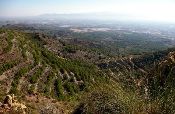| Sediment yield |
 |
|
Author: Matthias Vanmaercke, KU Leuven
In attempts to mitigate desertification, scientists have paid a lot of attention to ‘on site’ erosion processes at the hillslope scale. Generally, a large part of the eroded sediment is redeposited again before it reaches a river. Therefore, it is generally expected that the annual amount of sediment that reaches a catchment outlet (i.e. the ‘sediment yield’ of a river) is smaller than the total annual amount of on-site erosion that occurs in the catchment. As a result, catchment sediment yield has received relatively little attention in studies that assess the causes and impacts of desertification.
Analyses of large databases of measured hillslope erosion rates and catchment sediment yields indicated that this is generally not true for the Mediterranean region where catchment sediment yields are generally much higher than would be expected from the on-site erosion rates. Soils on Mediterranean hillslopes are often very shallow and stony, making them relatively less susceptible to erosion. However, the water that runs off from these hillslopes can cause serious erosion problems further downstream due to other processes such as gully erosion, landslides and riverbank erosion.
High catchment sediment yields can cause various problems. One of the most important is the storage capacity loss of reservoirs, since large volumes of sediments are often trapped in reservoirs. Hence, high catchment sediment yields can threaten future water supplies. Sediment yield is also closely linked with various environmental/ecological issues and can lead to higher flooding risks. Although the importance of these other erosion processes differs from catchment to catchment, these results clearly indicate that not only on-site erosion but also catchment sediment yield should be considered as an important desertification indicator.
The research conducted by K.U.Leuven and other partners of the DESIRE project therefore clearly indicated that it is both necessary and feasible to include catchment sediment yield in desertification assessment studies. Details on how sediment yield can be used as a desertification risk indicator are given in the references below.
|

Acknowledgement
The DESIRE project was
|
DESIRE brought together the expertise of
26 international research institutes
and non-governmental organisations.
This website does not necessarily
represent the opinion of the
European Commission. The European
Commission is not responsible for
any use that might be made of the
information contained herein. 


